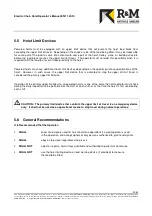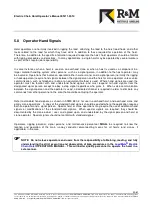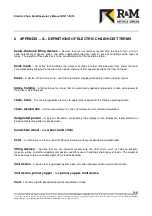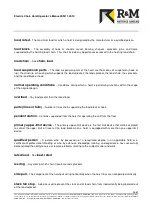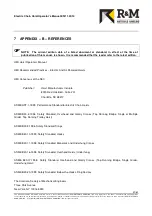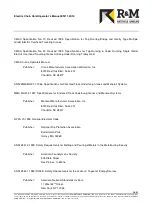
Electric Chain Hoist Operator’s Manual/EN/11.30.10
39/41
This document and the information contained herein, is the exclusive property of R&M MATERIALS HANDLING, INC. and represents a non-public, confidential and proprietary trade
secret that may not be reproduced, disclosed to third parties, altered or otherwise employed in any manner whatsoever without the express written consent of R&M MATERIALS
HANDLING, INC. . Copyright © (2010) R&M MATERIALS HANDLING, INC. . All rights reserved.
8 APPENDIX – C – RECOMMENDED PRACTICES – ELECTRIC
POWERED HOISTS
RECOMMENDED PRACTICES - ELECTRIC POWERED HOISTS
Because
R&M Materials Handling, Inc.
has no direct control over the hoist and its operation, conformance with
good safety practice is the responsibility of the user and operating personnel. ANSI/ASME B30.16 has been
used as a guide in preparing this list of
SHALLs
and
SHALL NOTs
. Ask your supervisor for a copy. Each is
identified according to
ANSI / NEMA Z535.4
with either the signal word
CAUTION
or
WARNING
to indicate the
degree of seriousness
m
WARNING:
Improper operation of a hoist can create a
potentially hazardous situation, which, if not
avoided, could result in death or serious injury.
To avoid such a potentially hazardous situation,
the operator SHALL:
1.
NOT
operate a damaged, malfunctioning or
unusually performing hoist.
2.
NOT
operate the hoist until you have thoroughly
read and understood the Operator’s Manual and
the Installation and Maintenance Manual
provided with this hoist.
3.
NOT
operate a hoist that has been modified
without the manufacturer’s approval or without
certification that it is in conformity with
ANSI/AMSE B30 volumes.
4.
NOT
lift more than rated load for the hoist.
5.
NOT
use hoist with twisted, kinked, damaged, or
worn load chain.
6.
NOT
use the hoist to lift, support, or transport
people.
7.
NOT
lift loads over people.
8.
NOT
operate a hoist unless all persons are and
remain clear of the supported load.
9.
NOT
operate unless load is centered under
hoist.
10.
NOT
attempt to lengthen the chain or repair
damaged load chain.
11. Protect the hoist’s chain from weld splatter or
other damaging contaminants.
12.
NOT
operate hoist when it is restricted from
forming a straight line from hook-to-hook in the
direction of loading.
13.
NOT
use load chain as a sling, wrap load chain
around load.
14.
NOT
apply the load to the tip of the hook or to
the hook latch.
15.
NOT
apply load unless load chain is properly
seated in the chain wheel(s) or sprocket(s).
16.
NOT
apply load if bearing prevents equal
loading on all load supporting chains.
17.
NOT
operate beyond the limits of the load chain
travel.
18.
NOT
leave load supported by the hoist
unattended unless specific precautions have
been taken.
19.
NOT
allow the load chain or hook to be used as
an electrical or welding ground.
20.
NOT
allow the load chain or hook to be touched
by a live welding electrode.
21.
NOT
remove or obscure the warnings on the
hoist.
22.
NOT
operate a hoist on which the safety
placards or decals are missing or illegible.
23.
NOT
operate a hoist unless it has been securely
attached to a suitable support.
24.
NOT
operate a hoist unless load slings or other
approved single attachments are properly sized
and seated in the hook saddle.
25. Take up slack carefully – make sure load is
balanced and load holding action is secure
before continuing.
26. Shut down a hoist that malfunctions or performs
unusually and report such malfunctions.
27. Make sure hoist limit switches function properly.
28. Warn personnel of an approaching load.







